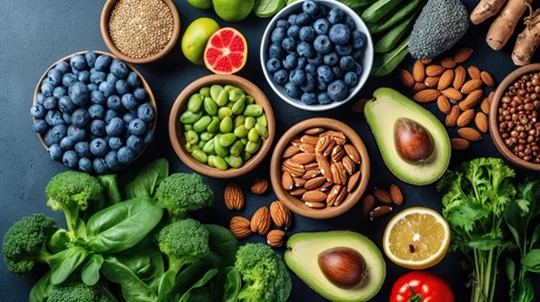The term “superfood” is often used so loosely that it can feel like marketing hype. But when it comes to managing diabetes, some foods truly earn the “super” title. These aren’t exotic, hard-to-find ingredients with magical properties. They are everyday, nutrient-dense powerhouses that can have a profound and positive impact on your blood sugar, heart health, and overall vitality. Think of Superfoods for Diabetes not as a cure, but as powerful tools in your wellness toolkit.
This guide will cut through the noise and provide a practical, evidence-based list of the top 10 superfoods that should be on every person’s diabetes-friendly grocery list. We’ll explore why each one is so beneficial and give you simple, delicious ways to make them a regular part of your life. It’s time to stop focusing only on what to avoid and start embracing the foods that will help you thrive.
What Makes a Food “Super” for Diabetes?
Before we jump into the list, let’s define what qualifies a food as a “superfood” in the context of diabetes management. These foods aren’t chosen at random; they share a specific set of characteristics that make them uniquely suited for supporting your health goals.
- Low Glycemic Index (GI): They release sugar into the bloodstream slowly, preventing sharp spikes in blood glucose. Gaining a solid grasp of this concept by Understanding Glycemic Index is fundamental.
- High in Fiber: They are rich in both soluble and insoluble fiber, which slows sugar absorption, promotes fullness, and supports digestive health.
- Rich in Nutrients: They are packed with essential vitamins, minerals, and antioxidants that fight inflammation and protect your cells from damage.
- Contain Healthy Fats: Many of these foods are great sources of monounsaturated and polyunsaturated fats, including omega-3s, which are crucial for heart health. The role of Diabetes and Healthy Fats is a key part of a balanced diet.
The Top 10 Superfoods for Diabetes Control
Here are 10 of the most powerful and accessible foods to help you manage diabetes effectively and deliciously.
1. Leafy Greens (Spinach, Kale, Collards)
Why they’re super: Leafy greens are the definition of nutrient-dense. They are incredibly low in calories and digestible carbohydrates, so they have a minimal effect on blood sugar. At the same time, they are loaded with essential nutrients like vitamin C, magnesium, and polyphenols, which have powerful antioxidant properties.
Easy Tip: Don’t just relegate greens to a side salad. Wilt a large handful of spinach into your morning scrambled eggs, blend kale into a fruit smoothie (you won’t even taste it!), or stir collard greens into soups and stews.
2. Fatty Fish (Salmon, Sardines, Mackerel)
Why they’re super: People with diabetes are at a higher risk for heart disease, making heart-healthy foods essential. Fatty fish are the best source of the omega-3 fatty acids DHA and EPA. As confirmed by the American Diabetes Association, these fats can help reduce inflammation, lower triglycerides, and protect the lining of your blood vessels. Plus, fish is a carb-free source of high-quality protein.
Easy Tip: Aim for two servings of fatty fish per week. A simple baked or grilled salmon fillet with lemon and herbs is a quick and delicious meal. Canned sardines or salmon are also great, budget-friendly options to top a salad.
3. Berries (Blueberries, Strawberries, Raspberries)
Why they’re super: While fruits contain sugar, berries are a fantastic choice for people with diabetes. They are packed with fiber and some of the most powerful antioxidants on the planet (called anthocyanins, which give them their rich color). This combination helps slow down the glucose response, making them a sweet treat you can feel good about.
Easy Tip: Top a bowl of plain Greek yogurt or oatmeal with a cup of mixed berries for a flavorful and nutrient-packed breakfast.
4. Nuts (Almonds, Walnuts)
Why they’re super: Nuts offer a powerful trifecta of healthy fats, fiber, and protein. This combination is excellent for satiety and helps to blunt blood sugar spikes. Almonds are rich in magnesium, while walnuts are a great plant-based source of omega-3 fatty acids.
Easy Tip: A small handful (about ¼ cup) of raw nuts makes for a perfect, blood-sugar-friendly snack. Just be mindful of portions, as they are calorie-dense. Practicing the principles of Mastering Portion Control is key here.
5. Avocados
Why they’re super: Avocados are prized for their high content of heart-healthy monounsaturated fat and fiber. A single avocado can contain a significant portion of your daily fiber needs. The healthy fat is incredibly satisfying and helps slow the digestion of carbohydrates eaten at the same meal.
Easy Tip: Add half an avocado to your lunch salad, spread it on whole-grain toast instead of butter, or simply eat it with a spoon and a sprinkle of salt.
6. Chia Seeds
Why they’re super: Don’t let their small size fool you. Chia seeds are one of the most fiber-dense foods you can find. They are particularly rich in viscous fiber, which absorbs water to form a gel in your stomach. This dramatically slows digestion and the release of sugar into the bloodstream.
Easy Tip: Make a simple chia seed pudding by mixing 2-3 tablespoons of chia seeds with a cup of unsweetened almond milk. Let it sit for a few hours or overnight until it becomes a pudding-like consistency.
7. Beans and Lentils
Why they’re super: As a category, beans and lentils are champions for diabetes management. They have a very low glycemic index and provide an incredible combination of high-quality plant-based protein and fiber, making them both filling and blood-sugar friendly.
Easy Tip: Replace some of the meat in your chili with black beans or make a pot of our Hearty Lentil Soup Recipe to have on hand for easy lunches.
8. Greek Yogurt (Plain)
Why it’s super: Plain, unsweetened Greek yogurt is a fermented food that provides a great source of protein and probiotics. These beneficial gut bacteria have been linked to improved gut health and may even play a role in improving insulin sensitivity.
Easy Tip: Use plain Greek yogurt as a base for a breakfast bowl, a substitute for sour cream on tacos or chili, or blended into smoothies for extra creaminess and protein.
9. Cruciferous Vegetables (Broccoli, Cauliflower)
Why they’re super: This family of vegetables is high in fiber and low in digestible carbs. Broccoli, in particular, contains a compound called sulforaphane, which has been shown to have powerful anti-inflammatory effects and may help protect against the type of cellular damage often seen in diabetes.
Easy Tip: Roast broccoli florets with garlic and olive oil until tender and slightly crispy. Use riced cauliflower as a low-carb substitute for white rice. For more ideas, explore the Best Vegetables for Diabetes Control.
10. Cinnamon
Why it’s super: While it’s a spice, not a food, cinnamon has shown promising potential in diabetes management. Some studies suggest it can help lower blood sugar levels and improve the body’s sensitivity to insulin.
Easy Tip: It’s easy to incorporate! Sprinkle cinnamon into your morning coffee, on top of oatmeal, or into plain yogurt to add flavor without adding sugar.
Creating a Super-Powered Diabetes Plate
The easiest way to put this into practice is by using the Diabetes Plate Method. It’s a simple visual guide for building a healthy meal. A great starting point for this is our guide on Meal Planning for Diabetes.
- Fill half your plate with non-starchy vegetables (leafy greens, broccoli).
- Fill one-quarter of your plate with lean protein (fatty fish, lentils).
- Fill the final quarter with smart carbohydrates (berries, beans).
- Add a healthy fat like avocado or a sprinkle of nuts.
Beyond the Food: Other “Super” Habits
- Exercise: Regular physical activity helps your body use insulin more effectively. Learn more about The Role of Exercise in Managing Diabetes.
- Hydration: Staying hydrated is crucial. Discover Why Hydration is Important for Diabetes.
- Sleep: Don’t underestimate the Sleep and Diabetes connection. Poor sleep can wreak havoc on your blood sugar.
While no single food is a magic bullet, making these 10 Superfoods for Diabetes a regular part of your diet is a powerful, proactive, and delicious step you can take. They are not just “safe” to eat; they are tools that can help you manage your condition and thrive.
Check out the author’s book here: Diabetic Air Fryer Cookbook.


Leave a Reply